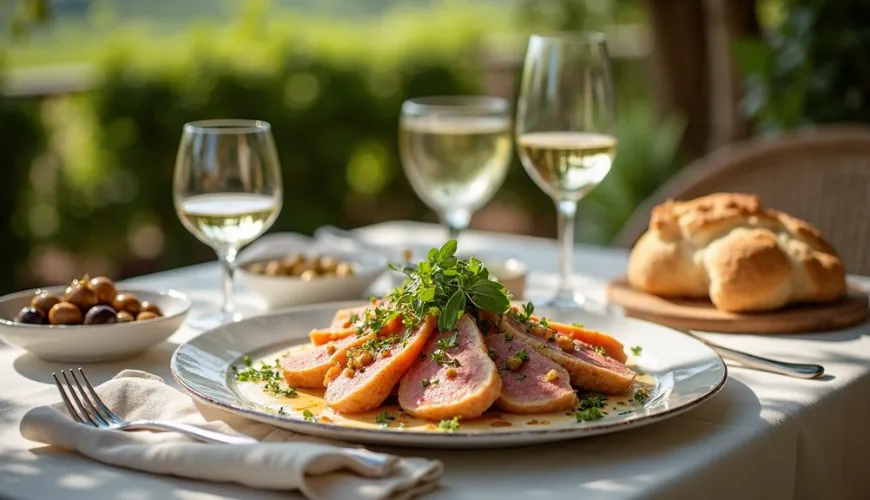
The Story of Vitello Tonnato and Its Journey to Worldwide Popularity

The Secret of Italian Delicacy - Vitello Tonnato
At the heart of Italian cuisine lies a dish that may seem unusual at first glance, but once you taste it, you'll understand why it has earned a place on tables across Europe. Vitello tonnato, or veal with tuna sauce, is one of those dishes that you either love at first bite, or you need to gradually appreciate through its flavor nuances. It's a combination that seems unlikely – gently cooked veal and a smooth, intensely flavored sauce made from tuna, anchovies, and capers. Yet, this peculiar pairing creates a harmony that only Italian cuisine can achieve.
How Did Vitello Tonnato Originate?
Although vitello tonnato has its roots primarily in the Piedmont region of northwestern Italy, its popularity has spread further, mainly due to its refreshing taste and versatility. This dish is often found on menus during the summer months because it is served cold and its lightness fits perfectly with the hot weather. According to historians, its origins date back to the 18th century when noble kitchens began experimenting with the combination of roasted meat and fish sauces. Although tuna was a luxury at the time, today almost anyone can indulge in this specialty.
Interestingly, the dish not only spread across Italy but also found its way to South America, particularly Argentina, where it is widely known as " vitel toné". There, it has become a traditional Christmas dish, which only confirms its ability to adapt to different cultures and tastes.
What Makes Vitello Tonnato So Special?
Above all, it's the unconventional combination of flavors – juicy veal, cooked or roasted to tenderness, and a sauce that combines the saltiness of the sea with the gentle acidity of lemon and capers. The entire dish is typically adorned with thin slices of meat, drizzled with smooth sauce, and the final effect is often completed with fresh herbs or extra capers. The result is a dish that is simple in appearance but utterly complex in flavor.
Imagine a summer lunch on a shaded terrace overlooking a vineyard. On the table, a carafe of chilled white wine, fresh focaccia, marinated olives – and in the center, a bowl of vitello tonnato. The first bite surprises you – the veal is soft, almost falling apart under the fork. The sauce is creamy but not heavy. The saltiness of the tuna blends with the acidity of the lemon and the pronounced taste of anchovies, while capers provide a sharp counterpoint. It's a dish that has depth and elegance, yet feels light and natural.
Vitello Tonnato Recipe - A Classic That Needs No Shortcuts
Although there are many variations, the classic recipe for vitello tonnato adheres to several proven rules. The foundation must always be a quality piece of young veal – ideally tenderloin or rump. The meat is first gently simmered or roasted with root vegetables, possibly with wine and broth. It is crucial that it remains tender and not dried out.
The sauce is then a chapter in itself. It is made from canned tuna, usually in oil, along with anchovies, capers, eggs, and olive oil. In modern versions, mayonnaise, lemon juice, and sometimes a little mustard are added. All ingredients are blended until smooth, creating a silky, slightly spicy sauce with a strong fish flavor.
Recipe in a nutshell:
- 600 g veal (tenderloin or top round)
- 1 carrot, 1 stalk of celery, 1 small onion
- 1 glass of white wine (optional)
- salt, pepper, bay leaf
For the sauce:
- 150 g tuna in oil
- 4-5 anchovies
- 2 tablespoons capers
- 2 egg yolks or mayonnaise (about 100 ml)
- 1 teaspoon Dijon mustard
- juice of half a lemon
- olive oil as needed
All sauce ingredients are blended until smooth and seasoned to taste. The meat is cooled after cooking, sliced very thinly, and served with the sauce on top.
When You Hear "Vitello Tonnato Ridi"
You might have come across the term “vitello tonnato Ridi” while searching for a recipe. This is not a special variant of the dish but rather a mistranslation or typo – it is likely a misrepresentation of a phrase or brand. In Italy, the dish is indeed called "vitello tonnato," and there is no official "Ridi" associated with it. If you encounter a similar term in an online recipe, it is wise to check its origin and stick to reputable sources. Recommendations like Giallo Zafferano, La Cucina Italiana, or Serious Eats are among the reliable ones.
When and How to Serve Vitello Tonnato?
This dish is best suited as an appetizer or light main course, often accompanied by a fresh green salad or bread. Due to its cold nature, it is an ideal meal for summer picnics, festive tables, or as an original treat for guests.
In restaurants, vitello tonnato is sometimes served as part of antipasti, sharing a plate with other specialties such as prosciutto, grilled vegetables, or marinated artichokes. At home, it is also an excellent choice for a buffet table, as it can be prepared in advance and remains fresh for several hours.
And what wine to pair with it? Italians usually opt for a light white wine like Arneis, Gavi, or Vermentino, which accentuates the freshness of the sauce without overshadowing the delicacy of the meat.
Quality Ingredients Are Key
One of the secrets to the success of vitello tonnato is the emphasis on fresh and high-quality ingredients. The veal should be tender and free of unnecessary sinews, the tuna ideally from sustainable fishing, and the anchovies of high quality – ideally in glass and in olive oil. As with most traditional recipes, the principle of less is more applies here. There is no need to complicate the dish if you have good ingredients at hand.
As one of the Italian culinary masters Massimo Bottura says: "A great ingredient is one that makes you think about how to honor it, not how to mask it."
In conclusion, although vitello tonnato may seem to be for discerning gourmets, it is not difficult to incorporate into home cooking. It just takes a little patience, a blender, and a desire to try something different. The result will be a dish that remains memorable – and perhaps even on your family menu.

